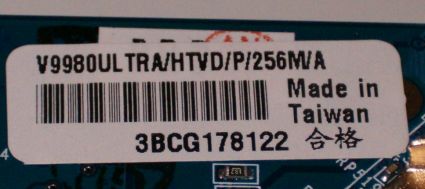Introduction
Yep, ASUS still do NVIDIA

With the recent announcement by ASUS, the worlds largest single manufacturer of consumer graphics cards, to start selling boards based on ATI's Radeon GPU family, you'd be forgiven for thinking they had left long time partners NVIDIA behind.
That couldn't be further from the truth. Still going strong, despite recent well publicised problems with their current GPU line, NVIDIA are still happily supplying GPUs to the Taiwanese behemoth. ASUS, for their part, are extremely happy to use them. The competition in the consumer graphics sector; ATI and NVIDIA fighting for the lion's share of the spoils and upstart companies like XGI happy to pick up scraps, means that ASUS doesn't have to put all its eggs in one GPU basket. They get the best deal, competition between its two big suitors (and suitors they'll be, courting ASUS for sales) will drive down prices for parts and it gives them a broad spectrum of products to offer.
So while recent ATI equipped ASUS products have seen all the current, fall refresh, press, there are still NVIDIA based products for us to look at.
The high end sector of consumer graphics is a curious one. It usually drives brand awareness more than any other sector, despite having very low sales compared to the mid-range, since consumers like the peek at performance they'll have in their mainstream accelerators in the coming year. Cards are often sold at a loss too; ATI announced to Wall Street this year that R420, their upcoming new high-end GPU part, due to arrive early next year, may be sold at a loss, simply to hold on to the performance crown at any (to a certain degree) cost. If it means undercutting whatever NVIDIA can come up with next, ATI will more than likely do so. Big competition for not much gain, reputation is king.
ASUS' recent high end ATI board, their Radeon 9800XT/VTD, brought massive performance and VIVO features to the top-end Radeon market, something that no other ATI card producer does (VIVO features are limited to AIW products with all other manufacturers). Wrapped in a non-reference cooler and carrying a big price tag, it's arguably the best graphics card money, albeit a lot of it, can buy.
It also stands to reason they have a matching NVIDIA based part, so it was no surprise that a GeForceFX 5950 Ultra (NVIDIA's latest pixel pusher, broadly equivalent to 9800XT in performance and features) based card in the same mould would turn up sooner or later. The helpful CityLink courier (hi Andy if you're reading) dropped one off last week and with a gap in testing of other hardware on my pile, it duly made its way into a configured box and the requisite benchmarks were run.
So while we've seen a couple of 5950 Ultra's already at HEXUS, giving us an educated guess as to what any other board based on the same GPU will perform like, ASUS usually do things a bit differently to reference designs. Let's take a closer look at the ASUS V9980U/TVD to see if that still applies.
Before we make a break for a new page, here's the spec list for 5950 Ultra, blatantly cut-and-paste from my AOpen Aeolus GeForceFX 5950 Ultra review. If you want GPU background, check out the reference card review here.
| GeForce FX 5950 Ultra | Radeon 9800XT | |
| GPU Name | NV38 | R360 |
| Transistor count | Unknown | Unknown |
| Manufacturing process | 130 nanometre | 150 nanometre |
| Pixel pipelines | 8 (**4) | 8 |
| Pixel shader units | 1 per pipe | 1 per pipe |
| Memory bus width | 256-bit/32-byte | 256-bit/32-byte |
| Texturing units | 1 (**2) per pipe | 1 per pipe |
| Core clock | 475MHz | 412MHz |
| Memory clock | 950MHz DDR | 730MHz DDR |
| Pixel fillrate | 3800 Mpixels/sec (**1900Mpixels/sec) | 3296 Mpixels/sec |
| Texture fillrate | 3800 Mtexels/sec | 3296 Mtexels/sec |
| Memory bandwidth | ~30.40GB/sec | ~23.36GB/sec |










